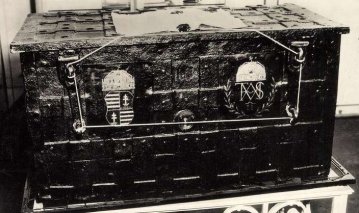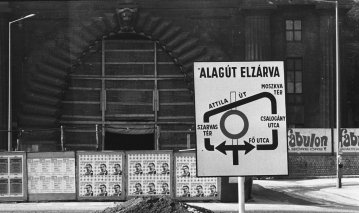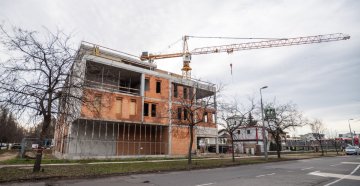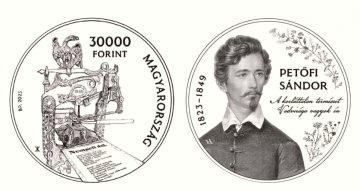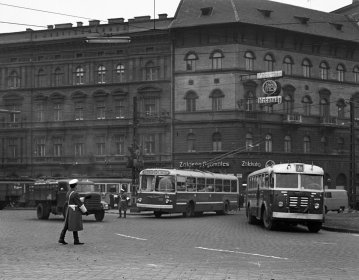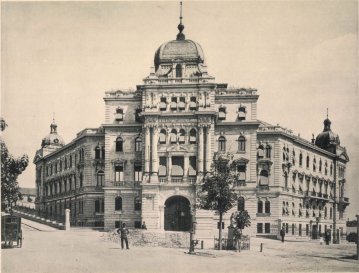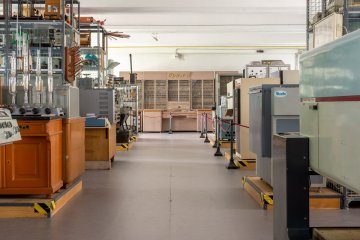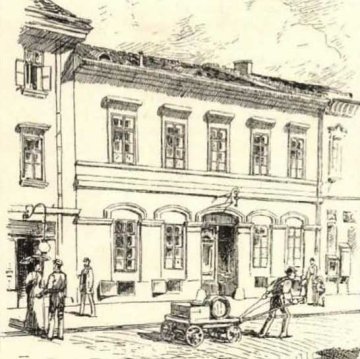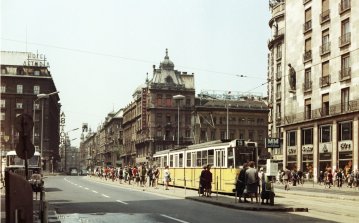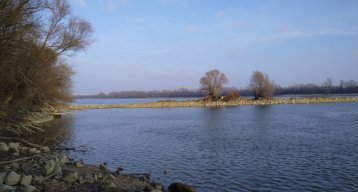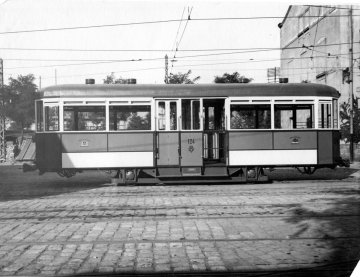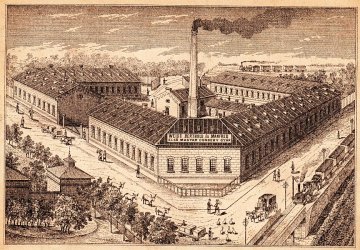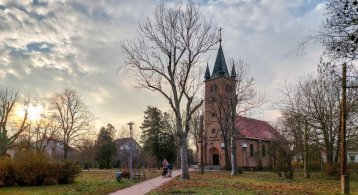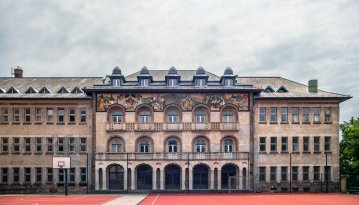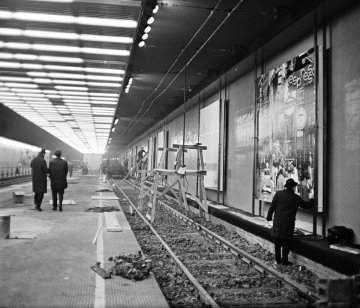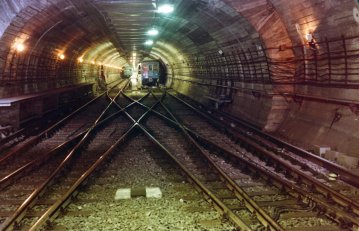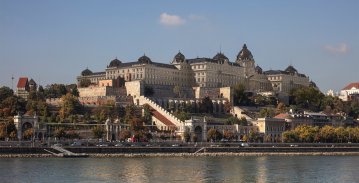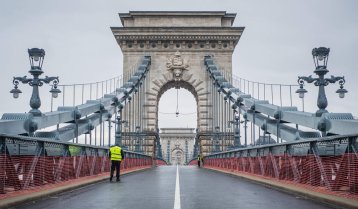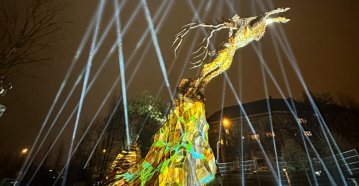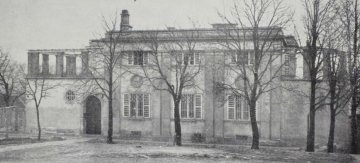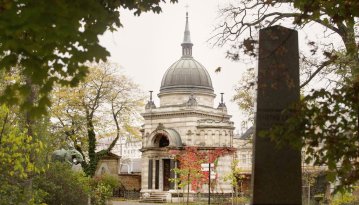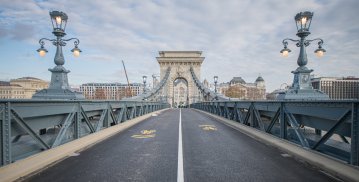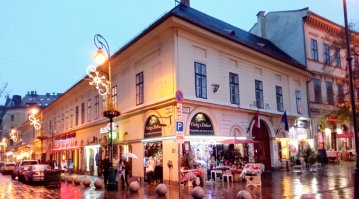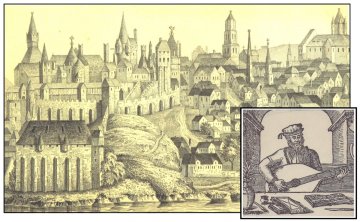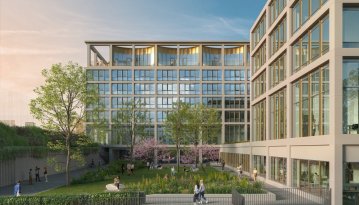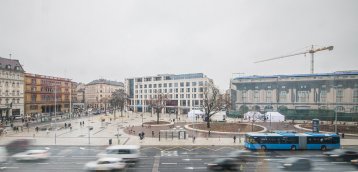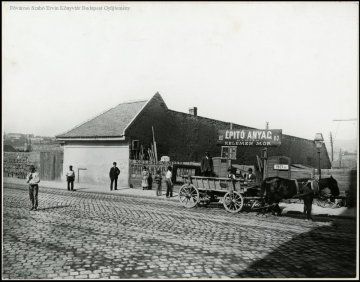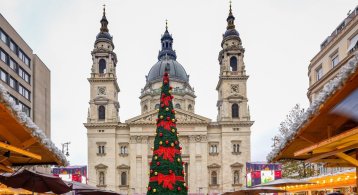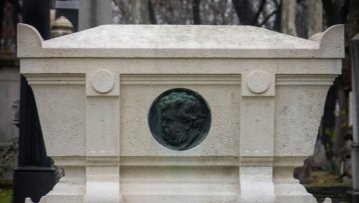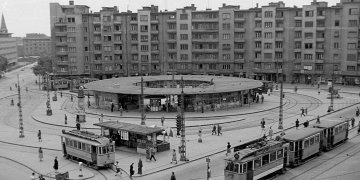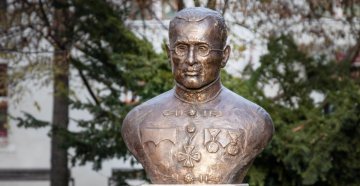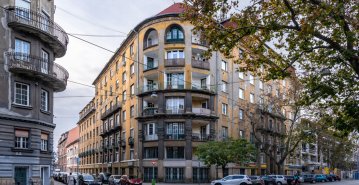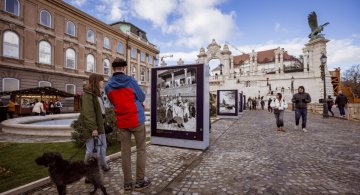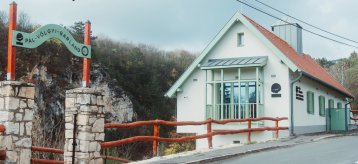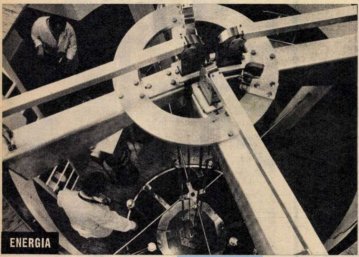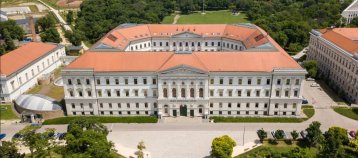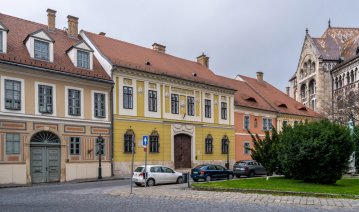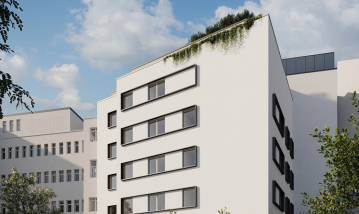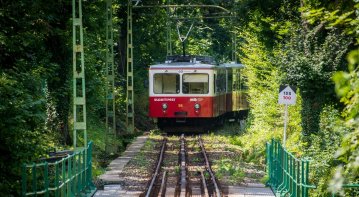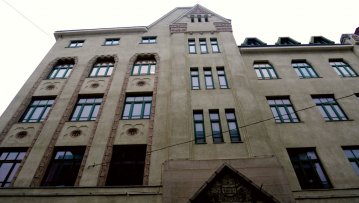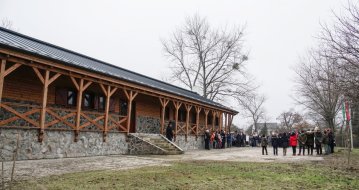 The „intertwined history” of the bridges and the city of Budapest
Which ideas and events have shaped the fate of bridges of Budapest and the cityscape? Alongside many other interesting facts, this question is also answered this newly published book by the Budapest City Archives, which introduces the history of bridges in Budapest.
The „intertwined history” of the bridges and the city of Budapest
Which ideas and events have shaped the fate of bridges of Budapest and the cityscape? Alongside many other interesting facts, this question is also answered this newly published book by the Budapest City Archives, which introduces the history of bridges in Budapest.
Search result
Hidden in the Strong Room - This is how the Holy Crown was kept in Buda Castle
January 9, 2023 at 1:30 PM
Today, it is taken for granted that anyone can view the Holy Crown of Hungary. But for centuries it was stored in a closed chest with iron straps, protected by keys and seals, and could only be taken out on special holidays, such as the coronation in 1867, the millennium celebration in 1896 or the Eucharistic Congress in 1938. On the occasion of the return of the fearfully guarded national treasure 45 years ago, Pestbuda presents the conditions under which the crown was guarded in Buda Castle.
The renovation of the Buda Castle Tunnel began 50 years ago on the occasion of the 100th anniversary of the city unification
January 8, 2023 at 2:00 PM
The Buda Castle Tunnel is an important traffic route in Budapest and also an interesting technical monument. When it was handed over in 1857, it was part of the route leading to the only bridge at the time, and it has not lost its traffic importance even into the 21st century. Although it was designed for horse-drawn carriages, today it is used by cars. The current appearance of the passage took shape 50 years ago, the Tunnel was closed on 8 January 1973 due to the works.
The Bulgarian Cultural and Education Centre in Ferencváros held a topping-out ceremony on Epiphany Day
January 6, 2023 at 8:30 PM
The Bulgarian Cultural and Education Centre is to be built on the plot opposite the Bulgarian community centre in the 9th District, near the Orthodox church. The building's topping-out ceremony was held on Epiphany Day, 6 January, which coincides with the Orthodox Christmas Day.
Petőfi, the Hungarian National Archives and the Riding Hall to be on the collector coins
January 6, 2023 at 3:00 PM
The Hungarian National Bank is issuing a total of 24 collector coins this year, in a total of 14 different themes. The new coins feature, among others, the 200-year-old National Anthem, Sándor Petőfi, Mihály Csokonai Vitéz, and the Hungarian National Archives, which is celebrating its 300th anniversary. There will be a hexagonal coin as well, such as the new element of the National Hauszmann Program series, the Riding Hall.
The Holy Crown has returned home – Hungarian relics were taken off the American plane to the sounds of the Rákóczi March
January 6, 2023 at 10:00 AM
On 5 and 6 January 1978, Budapest and Hungary became the centre of attention in the international press. The reason for this was that it was then that the United States of America returned the Holy Crown to the Hungarian nation. The Holy Crown was solemnly received in Budapest.
BKV was established 55 years ago - There was a ticket inspector on all vehicles and one could travel cheaply
January 4, 2023 at 11:00 AM
On 1 January 1968, Budapest Transport Company took over the capital's public transport from three other companies. Until then, Budapest's trams, buses, suburban railways and other means of transport were operated by three independent companies, the Metropolitan Electric Railway Municipal Company, the Metropolitan Bus Municipal Company, and the Metropolitan Suburban Railway Municipal Company. In addition, the new organisation absorbed the Municipal Shipping Company.
The headquarters of the Hungarian Central Statistical Office is 125 years old
January 3, 2023 at 3:30 PM
The Hungarian Royal Central Statistical Office was established in 1871. For a long time, the institution did not have an independent home and was constantly forced to move. The turning point occurred in 1896 when a legal article was published on the construction of the independent building. The plans were prepared by the renowned architect and university professor Győző Czigler. The handover of the new headquarters took place on 18 December 1897, but the staff of the office only took possession of the building in January 1898.
The Museum of Technology was founded three times - Unparalleled Hungarian memories are preserved in the collection created 50 years ago
January 2, 2023 at 5:00 PM
Fifty years ago, the Hungarian Museum of Technology was founded for the third time. According to the founding document dated 1 January 1973, its task is to collect and present Hungarian natural science and technical memorabilia. The museum preserves such special treasures as Ányos Jedlik's electric motor created in 1828 and his electric car made in 1855, the world's first carburettor engine, the first Hungarian computer and the very first Gömböc.
This is how Sándor Petőfi and Júlia Szendrey lived in Pest after their honeymoon
January 1, 2023 at 6:30 PM
Sándor Petőfi, who became a young, patriotic poet, moved from sublet to sublet in Pest in the early 1840s, but love and marriage changed his life: he went from subtenant to main tenant. Pestbuda recalls these locations on the 200th anniversary of the birth of the great national poet, showing in which street, in which house, and under what conditions he lived with his young wife after the marriage and the honeymoon.
This is how Budapest developed in 2022 - Several public buildings were handed over this year
December 31, 2022 at 11:00 AM
2022 will almost certainly go down in history with a negative tone, as it was burdened by a series of crises from which Hungary could not extricate itself. Nevertheless, Budapest developed very nicely, many investments were completed this year: several new buildings were completed and many monuments were restored. On the last day of the year, Pestbuda looks back and summarises the events of the year.
The last tram passed through Rákóczi Road and Erzsébet Bridge 50 years ago
December 30, 2022 at 6:00 PM
Tram traffic started on Rákóczi Road already 125 years ago, and there was a time when five different lines passed through here. But the means of transport, which is very popular with the travelling public, was gradually pushed out of the inner city districts. The last tram passed through Rákóczi Road and Erzsébet Bridge 50 years ago, on 31 December 1972, and its journey ended at Móricz Zsigmond Square. The demolition of the tracks soon began. In recent years, it has been brought up more and more often that the tram should be brought back to this route.
Háros, the beauty of the southern ends
December 29, 2022 at 3:00 PM
The capital's natural beauties are quite scattered. This is perhaps fortunate in that every district has at least one park, forest or waterfront. During this trip, Pestbuda will take a look at the southernmost part of the main branch of the Danube near Budapest. The region where the wide, slow-flowing Danube has been touching the quiet settlements for thousands of years. This region is the most beautiful part of the 22nd District along the Danube: Háros.
Beszkárt, the capital's public transport company, was founded 100 years ago
December 28, 2022 at 6:00 PM
Budapest's public transport was operated by several companies for a long time, for example, there was a period when the tram services only were operated by three different companies. But 100 years ago, the Budapest Székesfővárosi Közlekedesi Részvénytársaság [Budapest Capital Transport Company], or Beszkárt, was founded, which soon gained control over all the capital's means of public transport.
The death of Baron Manfréd Weiss of Csepel, a member of the House of Magnates
December 27, 2022 at 1:00 PM
Manfréd Weiss, a canner, became one of the richest Hungarian tycoons, the owner of Csepel Steel and Metal Works. When he died 100 years ago, they said goodbye to a wealthy industrialist who built a hospital, maternity home, sanatorium, nursery for his workers, and operated a soup kitchen for the poor. His huge empire, in which machine tools, sewing machines, stoves, bicycles, cars and aeroplanes were made, survived him by decades. The Csepel Steel and Metal Works Trust was dissolved in 1983, and independent companies were created from its units and tried to meet the increasingly difficult market challenges.
A little Transylvania on the edge of Budapest - Lutheran churches of Rákosmente
December 24, 2022 at 3:00 PM
The tiny Rákos Stream flowing through the edge of Pest gave its name to a series of quarters in the 16th and 17th Districts, including Rákosliget, Rákoskeresztúr, Rákosszentmihály, Rákoscsaba and Rákoshegy. There is also a great similarity in their built environment, they show a rural, small-town image. Moreover, they also share a high degree of similarity between their evangelical churches: they are reminiscent of Transylvanian fortified churches.
The foundation stone of the new gymnasium of the Baár-Madas Reformed High School in the 2nd District was laid
December 23, 2022 at 6:00 PM
On 19 December, the foundation stone of the newly constructed gymnasium of the Baár–Madas Reformed High School, Primary School and Student Dormitory in the 2nd District was laid. The new gymnasium is expected to be completed at the end of 2023.
The Batthyány Square terminus of the suburban railway was handed over 50 years ago
December 23, 2022 at 12:30 PM
The Budapest terminus of the suburban railway [HÉV] from Szentendre has been moved several times, most recently just 50 years ago, when it moved to its current location, Batthyány Square. The timing and the location were no coincidence either, as the suburban railway was able to connect to the metro this way which was also handed over at the time. The current terminus was handed over 50 years ago, but it may also change in the future.
Merger of Buda, Pest, Óbuda and Margit Island: 150 years ago the city unification law was announced
December 22, 2022 at 12:30 PM
Budapest is one of the most beautifully situated capitals in the world, something Hungarians can be really proud of. It is always nice when a foreigner marvels spectacularly, for example, at the panorama from the Castle. But Hungarians owe these ecstatic expressions not only to the gift of nature but also to the built environment created by our ancestors. Buda and Pest have lived in each other's neighbourhood for centuries, yet their unification provided the impetus that later resulted in so many fantastic buildings on both banks of the Danube. At the end of 1872, after a long history, the parliament passed a law on the merger of the cities, which was approved by the monarch on 22 December 1872 and was announced the next day.
Metro 2 was completed 50 years ago - Construction was started with spades and shovels
December 21, 2022 at 11:00 AM
Despite the fact that the first underground railway on the European mainland started in Budapest in 1896, the next underground railway section was completed in its entire length only fifty years ago, in December 1972. The construction lasted for more than twenty years and did not lack difficulties.
This is what the reborn Buda Castle will look like - From now on, anyone can see the plans
December 20, 2022 at 8:00 PM
The restoration of the Buda Castle has begun, and the visuals for its reconstruction have been published in the past few days, so now we know exactly what the building will look like after the reconstruction is completed. The Neo-Baroque royal palace was built between 1890 and 1905 with a significant expansion of the previous palace, but after 1945 it was rebuilt and simplified due to war damage. Anyone can see the reconstruction plans in the visitor centre that opened on Monday in Hunyadi Court.
"Life without music is incomplete and not worth living", said Zoltán Kodály who was born 140 years ago
December 18, 2022 at 11:00 AM
Zoltán Kodály is one of the greatest figures in Hungarian music literature, who was not only an exceptionally talented composer but also a researcher and teacher. He began his work as a folk song collector in 1905 and presented his own works to the public in 1910, and Psalmus Hungaricus, written in 1923, was a huge international success. His music pedagogy method is still used in education today. The composer's former home on Kodály Körönd now houses the memorial museum named after him.
Sightseeing with the Ikarus 66: the Museum of Transport invites everyone on a nostalgia trip
December 17, 2022 at 3:00 PM
In December and January, the Hungarian Museum of Science, Technology And Transport invites those interested to a special experience. People can visit the most beautiful places in Budapest with an Ikarus 66 retro bus, and during the trip, they can also get to know the world of the age of the vehicle. The nostalgia service starts today, people can get on the oldtimer-certified bus at Heroes' Square, at the entrance to the City Park Ice Rink.
The Chain Bridge has been handed over, but cars and pedestrians cannot drive over it yet
December 17, 2022 at 11:00 AM
From 16 December, the road on the Chain Bridge is available for those travelling with BKK vehicles, taxis, bicycles, motorcycles and mopeds. The bridge is scheduled to open to pedestrians in the fall of 2023.
The Miraculous Hind statue was handed over in the garden of the former Postal Palace
December 16, 2022 at 8:00 PM
The Miraculous Hind statue was inaugurated in the garden of the Hungarian National Bank Supervisory Centre and Money Museum, i.e., the former Postal Palace on Krisztina Boulevard. The symbol of the Money Museum, the five-metre-high work standing on a six-metre-high pedestal, which symbolises renewal, ascension, and abundance, can be clearly seen by pedestrians and motorists on Krisztina Boulevard from afar.
Scandalous background, sensational ending - The Lukács Villa on Ostrom Street is 100 years old
December 16, 2022 at 8:30 AM
The steep Ostrom Street, which opens into the Bécsi Kapu Square, is home to several valuable buildings, which are worthy of the prominent location with their sophisticated appearance. However, the history of the creation of the former Lukács Villa at number 5 is riddled with scandals, but this can also be attributed to the turbulent era. The walls of the villa, which was completed 100 years ago, hide this flaw, and to today's observer, they only tell about the designer's genius.
The first section of Hegyalja Road was completed 90 years ago
December 15, 2022 at 11:00 AM
Nowadays, Hegyalja Road is one of the most important traffic routes in Buda, as it connects Budaörsi Road with Erzsébet Bridge. Its existence is natural to everyone now, many people get to Lake Balaton this way, but when the original Erzsébet Bridge was built, the road was not yet ready: its first section, which was built by public workers during the economic crisis, was handed over 90 years ago. The investment caused controversy, some feared for the silence of the Tabán.
The death of Ábrahám Ganz caused a shock - He was the godfather of 64 factory workers' children, who all inherited
December 14, 2022 at 12:00 PM
Ábrahám Ganz, the respected manufacturer from Buda, committed suicide 155 years ago, on 15 December 1867. The Ganz Factory, barely more than 20 years old, was at the peak of its success, and Ganz himself was a recognised citizen of Buda. With his death, he left a huge void, as he had no heir who could have taken over the family business. However, the factory survived and rose to incredible heights.
The Chain Bridge will be opened on Friday: buses, taxis, motorbikes and bicycles can use it again
December 13, 2022 at 5:00 PM
From 16 December, BKK vehicles, taxis, and people travelling by bicycle or motorcycle can use the Chain Bridge. The renovation of the bridge continues, including the reconstruction of the monument elements and the construction of the pavement. Pedestrians are expected to be able to use the bridge after the completion of the final stage of the renovation in the fall of 2023.
The oldest building in Ferencváros stands on Kálvin Square - The story of the former Két Oroszlán Inn
December 13, 2022 at 11:00 AM
The house at 9 Kálvin Square is the oldest building not only on the square but also in the capital's 9th District that is still standing today. In the past two centuries, it has been through many things, it has been used for many things, but the most important thing is that it was used and this not very large, but cultural-historically significant building of Pest classicist architecture has survived.
A world star raised in Buda in the Middle Ages - memories of Bálint Bakfark and the street named after him
December 12, 2022 at 9:00 AM
In the heyday of the Renaissance, a lute artist educated in Buda went on a European tour to impress the rulers and noble courts of the continent with his brilliant music, even generating sympathy for the cause of the Kingdom of Hungary, which was languishing under the threat of the Ottoman Empire. As a student, Bálint Bakfark was able to see Buda just before the long Turkish occupation. His memory is preserved today by a small street, next to which the medieval city wall stretched.
The new campus of Corvinus is already under construction on the side of Gellért Hill, the renders have just been presented
December 11, 2022 at 5:00 PM
The design renders of the new campus of the Corvinus University of Budapest, which is already under construction in the 11th District, were presented. In the new university centre located at the junction of Ménesi Road and Mányoki Road, in addition to the educational buildings, innovation and community spaces will also play an important role, a 180-bed dormitory is being built, and an 11,000 square metre park will also serve the students' comfort. The new campus will be handed over next autumn.
The renovated Blaha Lujza Square was handed over - It was announced more than 5,5 years ago, it has now been realised
December 11, 2022 at 11:00 AM
On 10 December, the public could take possession of the renovated Blaha Lujza Square. The transformation of the square named after the "nightingale of the nation" was decided in 2017 by the General Assembly of Budapest, which allocated the necessary funds in March 2018. However, the actual work did not start until June 2021. The space that has just been handed over has turned out to be different in many ways than it was imagined five years ago.
Constructions in Pest 150 years ago, before the unification of the city
December 10, 2022 at 2:00 PM
Pest and Buda already prepared for the unification of the cities in 1872, a large-scale urban development plan was adopted in Pest, and large investments were decided upon. However, other buildings also rose in the city. Take a look at how the city developed and how much did it cost to build a residential building.
The Advent Basilica was chosen as the best Christmas market in Europe for the third time
December 10, 2022 at 10:00 AM
The Christmas market next to Saint Stephen's Basilica, the Advent Basilica, has become the best Christmas market in Europe for the third time. This year, the event even broke a record, as it won with the most votes of all time.
The Hungarian National Museum celebrated the 220th anniversary of its foundation
December 9, 2022 at 7:00 PM
The 220th anniversary of the foundation of the Hungarian National Museum was celebrated with a conference and the ceremonial inauguration of the reliefs commemorating the museum's three former directors.
The grave monument of Mihály Munkácsy in the Fiumei Road Cemetery to be renewed
December 9, 2022 at 3:00 PM
The tomb of Mihály Munkácsy, a creation of Ede Telcs, which is located in the Fiumei Road Cemetery and protected as a monument, is being renovated. According to the plans, the works will be completed by spring, and the renovated grave will be inaugurated on 9 May 2023, the 123rd anniversary of the painter's death.
The capital's tallest building, the new MOL headquarters handed over
December 9, 2022 at 9:00 AM
The MOL Campus, the tallest office building in Budapest, was handed over. The 143-metre-tall building next to the Kopaszi Dam opens its doors to the public in spring, and visitors can also go up to the observation terrace on the 29th floor. After the opening, the representatives of the 11th District of the historic churches blessed the building.
Playwright Gergely Csiky, who was born 180 years ago, was remembered in the Fiumei Road Cemetery
December 8, 2022 at 3:00 PM
Playwright Gergely Csiky, the creator of Hungarian bourgeois drama, was commemorated on the occasion of the 180th anniversary of his birth in the Fiumei Road Cemetery. The tomb, which has been protected since 2001, is located in one of the artist's plots of the cemetery and has been fully reconstructed. On the side of the Neo-Baroque ornamental sarcophagus made by Károly Senyei, the portrait of Gergely Csiky in relief can be seen.
An emblematic building, the Mushroom at Móricz Zsigmond Square is 80 years old
December 8, 2022 at 12:30 PM
Újbuda's emblematic building, the Mushroom [Gomba], is eighty years old this December. The traffic pavilion erected in 1942 at Móricz Zsigmond Square performed its original function for sixty years until the tracks running around it were demolished. The building remained unoccupied. By the time it came under the ownership of the 11th District Local Council from the capital, it was dilapidated, dirty, and unworthy of its architectural value and the atomic sphere of the place. A design competition was launched to save it, as a result of which the contemporary public space was born in 2014, which satisfies both elegant, functional and cultural needs.
The bust of Viktor Maderspach was inaugurated in the 16th District
December 7, 2022 at 6:00 PM
Transylvanian Hungarian writer, soldier, and engineer Viktor Maderspach received a bust in Erzsébétliget in the 16th District. After the proclamation of the Treaty of Trianon, he had to flee his native Transylvania, leaving his family’s estate behind. He found a new home in Mátyásföld in 1934.
The capital launched a housing construction program during a crisis in the 1920s
December 7, 2022 at 11:00 AM
During the period of dualism in Budapest, most residential buildings were built by private investors, as there was a huge demand for them at that time: large crowds moved to the capital. The trend continued even after World War I, but at that time the economic environment was not nearly as favourable, so the capital itself launched a small flat construction program. Several buildings were completed by November-December 1926, the first residents moved in ninety-six years ago.
Traditions of a vanished world - This is how they prepared for the holiday in the Carpathian Basin
December 6, 2022 at 8:00 PM
The open-air photo exhibition, which opened on 6 December on the Danube-facing terrace of the Buda Castle and in the Castle Garden Bazaar, invites visitors to take a real trip back in time. The old photographs show the Christmas customs of the peoples of the Carpathian Basin, now unknown to many, leading the visitors to a vanished world, to the time of their great-grandparents.
The new visitor centre of the Pál Völgyi Cave was handed over
December 6, 2022 at 6:00 PM
A modern, interactive exhibition has been created in the new visitor centre of the Pál-Völgyi Cave, on Szépvölgyi Road in the 2nd District. Visitors can get to know the cave systems of Buda, the protected bat species of the area, as well as touch the rare rocks and minerals created in the caves. During the development, the reception area of the cave was renewed, and a training room was also created.
The new experimental reactor in Csillebérc was commissioned fifty years ago
December 5, 2022 at 4:00 PM
On 5 December 1972, several physicists gathered in Budapest to celebrate the launch of a series of experiments that would last for 18 years. That is when the new reactor was inaugurated in Csillebérc, at the KFKI (Central Research Institute for Physics), where the physics research base of the Hungarian Academy of Sciences operated.
The Ludovica Academy: 150 years of Hungarian officer training
December 4, 2022 at 11:00 AM
One hundred and fifty years ago, in 1872, the Ludovica Academy, the military school for the training of officer cadets, was opened. The 1808 Diet decided to start Hungarian officer training, but the education actually started only 64 years later. The academy's own building in the 8th District was already built between 1830 and 1836 from public donations, according to the plans of Mihály Pollack, but the classicist palace was unused for decades. However, a law of 1872 once again ordered the establishment of the Hungarian Royal Hungarian Defense Academy.
A walk through time - The houses in the Buda Castle tell the story of nearly 800 years of Jewish history
December 3, 2022 at 10:00 AM
Although the history of Budapest's Jews is as old as the city itself, it is less well-known how many places we can find memories of the community and how many houses preserve stories from the Middle Ages to the 21st century. The tour guide of the Buda Castle Walks of the Castle Headquarters has now provided an insight into this during the Shalom, Buda! castle walk to Pestbuda.
The foundation stone of the new building of the specialist clinic in Ferencváros was laid
December 2, 2022 at 3:30 PM
The foundation stone of the new building of the health clinic in the 9th District, Mester Street, was laid. The institution's existing building will be expanded with a 6-story, 3,000-square-metre wing. The building will be built using the most modern technology, will have a green roof, and will be heated by a heat pump. The new building is planned to be completed in the spring of 2024.
The cogwheel railway will not be eliminated
December 2, 2022 at 8:00 AM
Accepting the proposal of the people of Hegyvidék, the General Assembly of the Capital decided to support the renovation of the cogwheel and the extension of its route. So they will not eliminate the railway. During the renovation, transportation will be provided with a so-called demand-controlled telebus.
A 110-year-old school building in Ferencváros - one of Albert Kálmán Kőrössy's masterpieces
December 1, 2022 at 9:00 AM
One of the large-scale masterpieces of Art Nouveau school architecture is bounded by three streets, Lenhossék, Vendel and Balázs Béla. Its main facade is so huge that people have to walk at least 50 metres away from it to admire its beauty. When it was completed, it stood out among the single-story houses in central Ferencváros. Nowadays, it is mostly surrounded by modern residential buildings, and perhaps there would be a residential building in its place too if it had not been given a new function a few years ago.
The rebuilt Tamariska Scout House in Csepel was handed over
November 30, 2022 at 8:00 PM
A scout house was built in 2019 on Tamariska Hill in Csepel, on the site of the former propane tank exchange, part of which burned down in February this year. The rebuilt Tamariska Scout House was inaugurated on Sunday.
 The „intertwined history” of the bridges and the city of Budapest
Which ideas and events have shaped the fate of bridges of Budapest and the cityscape? Alongside many other interesting facts, this question is also answered this newly published book by the Budapest City Archives, which introduces the history of bridges in Budapest.
The „intertwined history” of the bridges and the city of Budapest
Which ideas and events have shaped the fate of bridges of Budapest and the cityscape? Alongside many other interesting facts, this question is also answered this newly published book by the Budapest City Archives, which introduces the history of bridges in Budapest.
 The Bridge Report, which brought a turning point in the history of Budapest
A travel report that changed the history of Pest and Buda, as well as Hungary. The little book contributed to the change of half a thousand years of legal customs and the implementation of an investment of unprecedented size and technical quality. This book was The Bridge Report [Hídjelentés in Hungarian].
The Bridge Report, which brought a turning point in the history of Budapest
A travel report that changed the history of Pest and Buda, as well as Hungary. The little book contributed to the change of half a thousand years of legal customs and the implementation of an investment of unprecedented size and technical quality. This book was The Bridge Report [Hídjelentés in Hungarian].
 Drama on the university wall - The heroic monument was planned 95 years ago
In the constant hustle and bustle of the Egyetem Square in Pest, the students may not even notice the monument that decorates the short section of wall between the church and the central building of ELTE. However, it commemorates their predecessors, the heroes who fought for their country in World War I, and those who heroically helped them. The first design of the dramatically collapsing soldier was born in 1928, ninety-five years ago.
Drama on the university wall - The heroic monument was planned 95 years ago
In the constant hustle and bustle of the Egyetem Square in Pest, the students may not even notice the monument that decorates the short section of wall between the church and the central building of ELTE. However, it commemorates their predecessors, the heroes who fought for their country in World War I, and those who heroically helped them. The first design of the dramatically collapsing soldier was born in 1928, ninety-five years ago.

